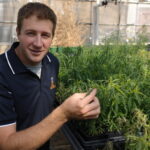2012
Evolved Resistance to Glyphosate in Junglerice (Echinochloa colona) from the Tropical Ord River Region in Australia

The objective of this study was to determine whether a jungle rice population from the tropical Ord River region of northwest Australia was glyphosate-resistant and whether alternative herbicides labelled for jungle rice control were still effective. Seed samples collected from the field site were initially screened with glyphosate in the glasshouse, and surviving individuals were self-pollinated for subsequent glyphosate dose-response studies. Glyphosate resistance was confirmed, as the suspected resistant population was found to be 8.6-fold more resistant to glyphosate than a susceptible population-based on survival (LD50 of 3.72 kg ha21), and 5.6-fold more resistant based on biomass reduction (GR50 of 1.16 kg ha21).
Herbicide resistance-endowing ACCase gene mutations in hexaploid wild oat (Avena fatua): Insights into resistance evolution in a hexaploid species” Heredity 2012

Many herbicide-resistant weed species are polyploids, but far too little about the evolution of resistance mutations in polyploids is understood. Hexaploid wild oat (Avena fatua) is a global crop weed and many populations have evolved herbicide resistance.
Harrington Seed Destructor: A new nonchemical weed control tool for global grain crops

Global grain production is under threat from the escalating evolution of herbicide-resistant weed populations. Worldwide, herbicide-reliant grain crop production systems have driven the proliferation of herbicide resistant populations of major weed species.
Synergistic effects of atrazine and mesotrione on susceptible and resistant wild radish (Raphanus raphanistrum) populations and the potential for overcoming resistance to triazine herbicides

The synergistic interaction between mesotrione, a hydroxyphenylpyruvate dioxygenase (HPPD)-inhibiting herbicide, and atrazine, a photosystem II (PS II)-inhibiting herbicide, has been identified in the control of several weed species.
Non target site mechanism of metribuzin tolerance in induced tolerant mutants of narrow-leafed lupin

Narrow-leafed lupin (Lupinus angustifolius L.) is an important grain legume crop in Australia. Metribuzin is an important herbicide used to control weeds in lupin crops. This study investigated metribuzin tolerance mechanism in narrow-leafed lupin by comparing two induced mutants (Tanjil-AZ-33 and Tanjil-AZ-55) of higher metribuzin tolerance with the susceptible wild type.
Non-target site based resistance to ALS-inhibiting herbicides in six Bromus rigidus

Bromus rigidus is a common weed species that has increased in cropping fields owing to limited control options. During a random field survey inWestern Australia, sixB. rigiduspopulations that had survived in-crop weed control programmes were collected. The study aimed to determine the resistance profile of these six populations.
Identification of resistance to either paraquat or ALS-inhibiting herbicides in two Western Australian Hordeum leporinum biotypes

Hordeum populations are becoming increasingly difficult to control in cropping fields. Two herbicide-resistant H. leporinum populations were identified during a random crop survey after herbicides were applied. The study aimed to determine the herbicide resistance profile of these H. leporinum biotypes to a range of herbicides used for their control.
Reducing the risks of herbicide resistance: Best management practices and recommendations

Herbicides are the foundation of weed control in commercial crop-production systems. However, herbicide-resistant (HR) weed populations are evolving rapidly as a natural response to selection pressure imposed by modern agricultural management activities.
Simulation modelling identifies polygenic basis of herbicide resistance in a weed population and predicts rapid evolution of herbicide resistance at low herbicide rates

The potential for low rates of diclofop-methyl to result in rapid evolution of herbicide resistance in a herbicide-susceptible Lolium rigidum (annual ryegrass) population was demonstrated in a recent cropfield study.
An Herbicide-Susceptible Rigid Ryegrass (Lolium rigidum) Population Made more susceptible

A wild population of a plant species, especially a cross-pollinated species, can display considerable genetic variation. Genetic variability is evident in differential susceptibility to an herbicide because the population can show continuous phenotypic variation.
1 2


